
Diamonds are like snowflakes in that no two are alike. The shape of a diamond is one factor that can make or break its value and appearance. But don’t worry, dear reader, because I will go over everything you need to know about diamond shapes in this blog post. I have got you covered on everything from the difference between diamond shapes and cut to the ideal length to width ratio for each shape and how different shapes affect prices. In addition, I will reveal the most popular diamond shapes for engagement rings. So sit back, relax, and let’s get started on this diamond adventure.
In This Article:
What is diamond shape?
Is diamond shape and diamond cut the same?
What are the different types of diamond shapes?
What is the length to width ratio of a diamond and why is it important?
How do different diamond shapes affect the price of a diamond?
The Bottom Line
FAQ on Different Types of Diamond Shapes
Summary
A diamond’s shape is defined by its contours and has an effect on the diamonds sparkle and radiance. The round diamond shape is the oldest shape of diamond dating back to the early 1700’s. Over time other shapes like square (princess cut), rectangles (emerald cuts) developed. Today a variety of shapes exist which I have delved in deeper in the subsequent sections. The shape of a diamond is normally the first thing that customers consider when shopping for their jewelry.
Most definitely not. Although used interchangeably diamond shapes and diamond cuts refer to two very different aspects of a diamond. Diamond shape as I explained earlier refers to the physical outline or form of a diamond. Diamond cut, on the other hand, refers to a diamonds proportions, symmetry and finish all of which are critical to maximizing the scintillation, fire and brilliance of a diamond. An excellent cut diamond refracts light in a way that maximizes its beauty and value while a poor cut diamond will look dull and cloudy as it has not been optimized to refract light
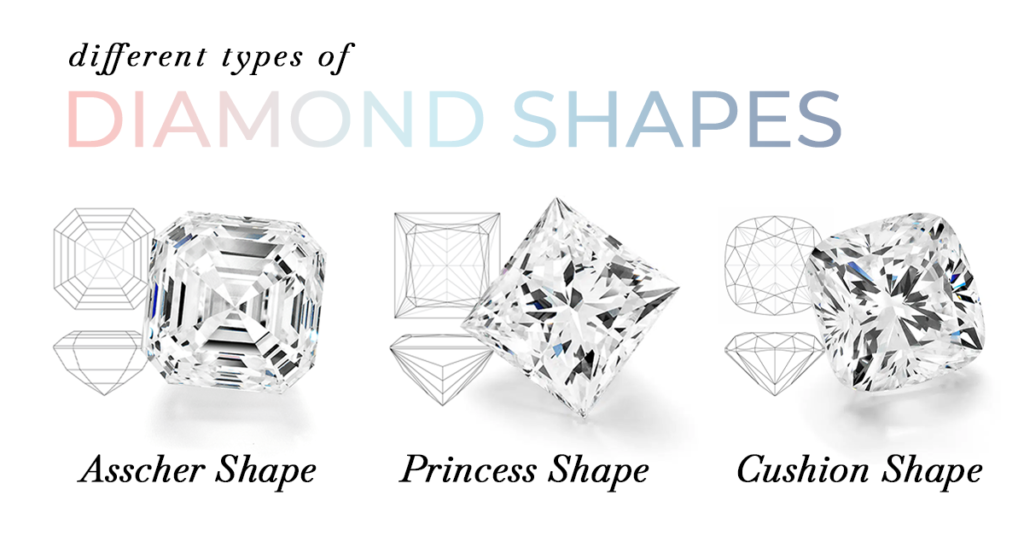
Each diamond shape has its own distinct appearance and characteristics, and selecting the right shape can have a significant impact on the overall beauty and value of a diamond. Following are the most popular shapes of diamonds
Round – This is by far the most popular shape for diamonds. A round diamond is circular in shape and famous for its brilliant sparkle and fire. Round diamonds have 58 facets and is the most prevalent shape used in jewelry
Princess – Another popular diamond shape is a square also known as a ‘Princess Cut’. It has pointed corners and, depending on the cut, can have 50 to 58 facets. Princess cut diamonds are known for their brilliance and contemporary appearance.
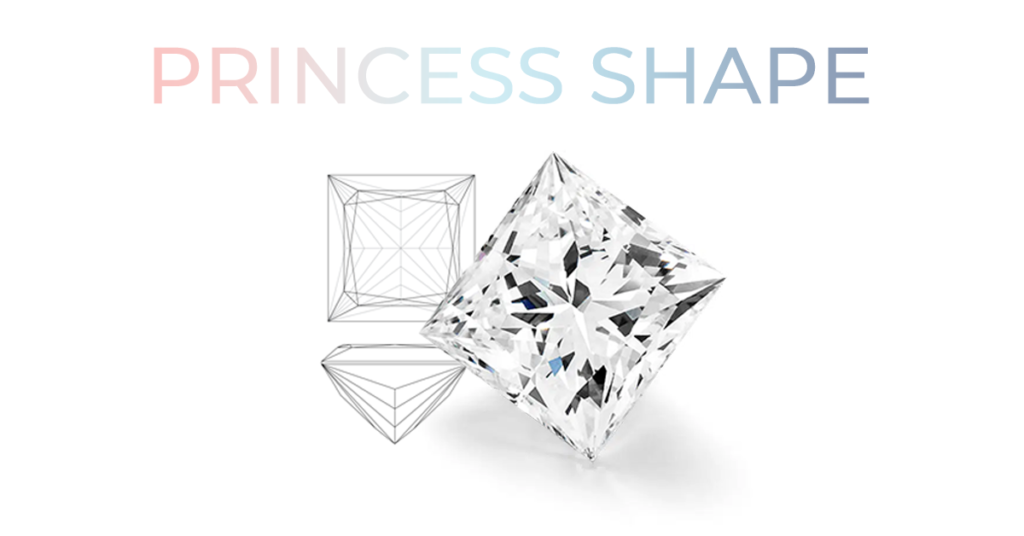
Emerald – This is a diamond having a rectangular shape but with cut off corners and facets that are step-cut, creating a unique hall of mirrors effect. The emerald cut is known for its understated elegance and can highlight the clarity and transparency of a diamond. Normally an emerald cut diamond has 57 facets
Asscher – Like the emerald cut, these diamonds are square or rectangular but have a more faceted appearance. Asscher diamonds have a vintage feel and a unique and sophisticated appearance and like the traditional round also have 58 facets
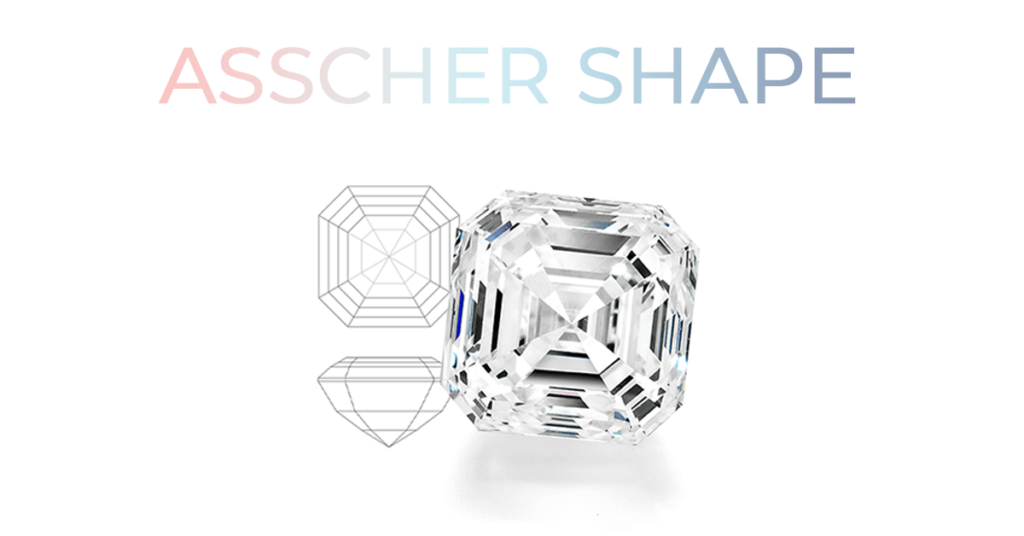
Oval – This elongated shape has a similar brilliance and fire to the round cut, but due to its elongated shape, it can offer a more flattering appearance. Depending on the cut, oval diamonds can have 56 to 64 facets.
Marquise – This pointed oval shape is named after the Marquise de Pompadour, King Louis XV of France’s mistress. Marquise diamonds are distinguished by their distinct and dramatic shape, which causes them to appear larger than other shapes of the same carat weight.
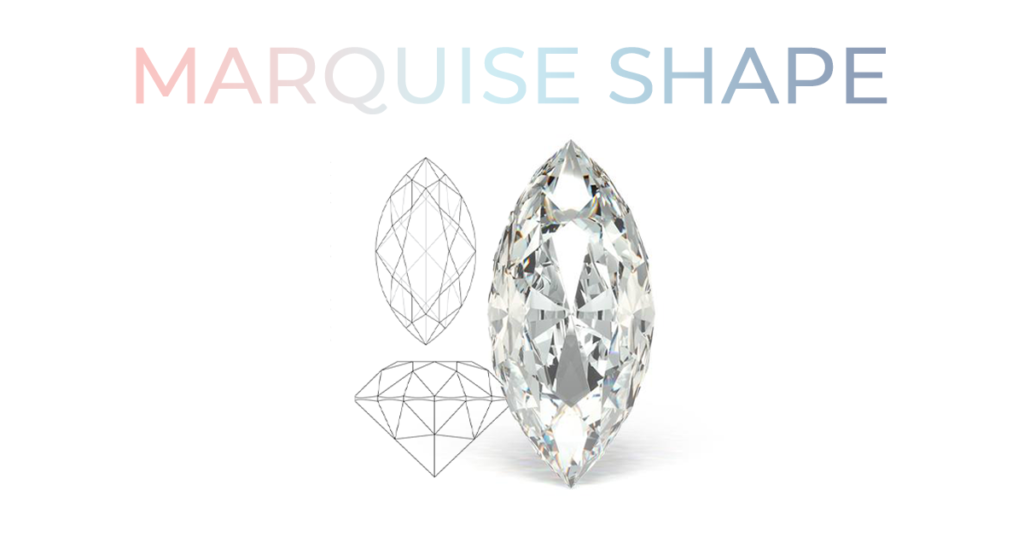
Pear – This teardrop shape combines round and marquise shapes to create a distinctive and elegant appearance. Pear-shaped diamonds with 56 to 58 facets can be worn with the pointed end facing up or down.
Heart – The heart is a popular shape for engagement rings because it is romantic and symbolic. A skilled cutter is required to achieve the perfect symmetry and shape of a heart-shaped diamond, which can have anywhere from 56 to 59 facets.
Cushion – This square or rectangular shape with rounded corners has a vintage appearance and a soft sparkle. Cushion diamonds can have 58 to 64 facets and are a great value for their size.
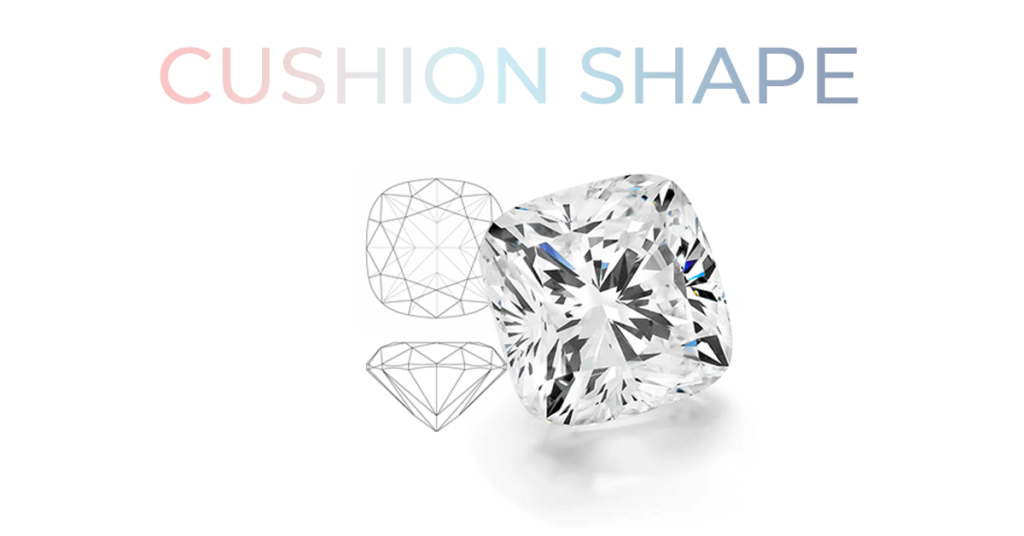
Radiant – A radiant cut combines the brilliance of a round cut with the shape of an emerald cut in a square or rectangular shape. Radiant diamonds have a distinct and versatile appearance, with facets ranging from 53 to 70 depending on the cut.
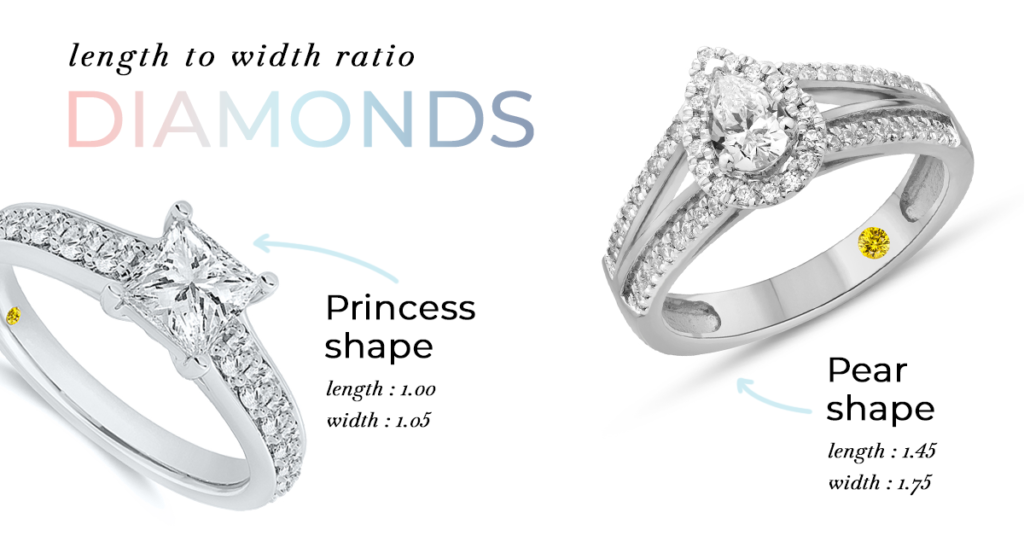
When choosing a diamond shape, the length to width ratio is an important factor to consider. It refers to the length-to-width ratio of a diamond and has a significant impact on its appearance and sparkle
The ideal length to width ratios for some of the most popular diamond shapes are as follows:
Round: A round diamond with a length to width ratio of 1.00 – 1.02 is most desirable as it maximizes brilliance, fire and scintillation of the diamond
Princess: With a length to width ratio of 1.00 – 1.05, a square shaped diamond also known as the princess shape is a popular alternative to round diamonds.
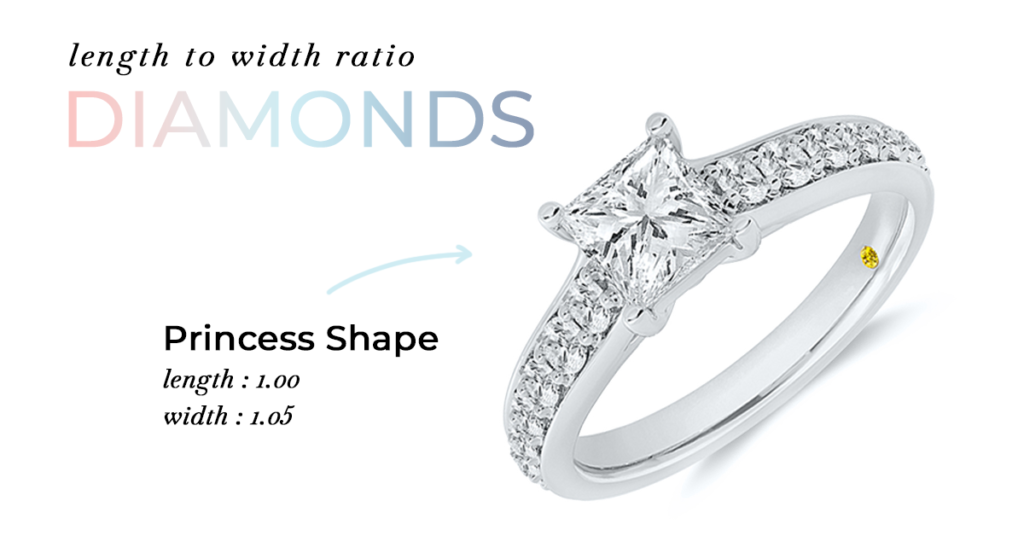
Emerald: An emerald cut diamond shape with a length to width ratio of 1.30 – 1.50, is most desirable as it step-cut facets that highlight the clarity and transparency of the diamond.
Asscher: The ideal length to width ratio of an asscher shape is 1.00 – 1.05 for maximum sparkle
Oval: A length to width ratio of 1.33 – 1.66 is ideal for an elongated oval shaped diamond.
Marquise: A marquise shaped diamond with a length to width ratio of 1.75 – 2.25 with its unique shape that tapers to a pointed end on either side is very popular due to its elegant style
Pear: With a teardrop shape that combines the round and marquise shapes, the ideal length to width ratio of a pear shaped diamond is 1.45 – 1.75.
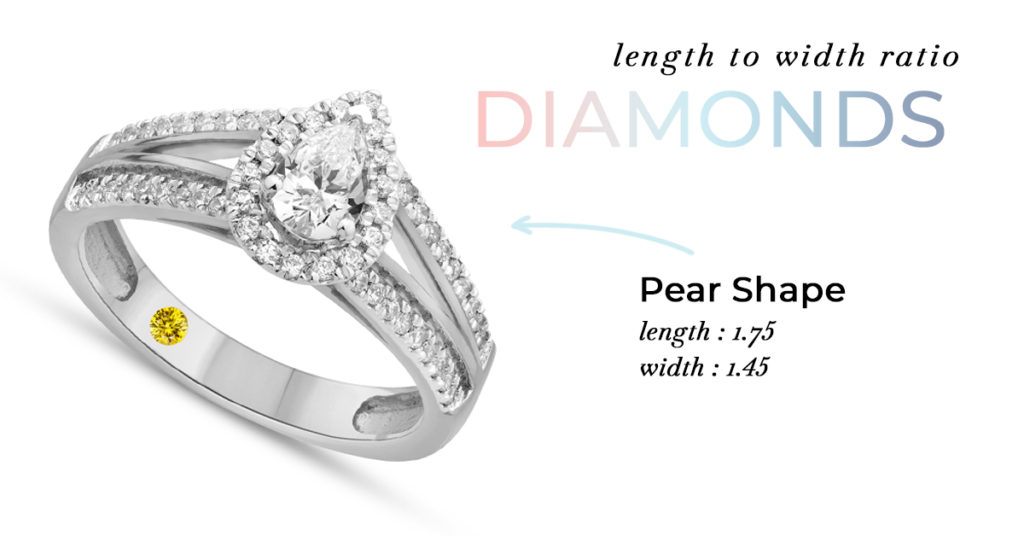
Heart: The heart shape has a length to width ratio of 0.90 – 1.10 and a distinct heart shape with variable symmetry.
Cushions: Cushion cut diamonds have a length to width ratio of 1.00 – 1.20, which when combines with their rounded corners, create a soft and romantic look.
Radiant: With a length to width ratio of 1.00 – 1.05 and its cropped corners, the radiant shape combines the elegance of emerald cuts with the brilliance of round cuts.
Understanding the optimal length to width ratio for each shape can assist you in selecting a diamond that will maximize its beauty and value.
A diamond’s shape can have a significant impact on its price. The round diamond, the most popular diamond shape, is generally the most expensive due to its high demand and the amount of rough diamond lost during the manufacturing process to achieve its optimal sparkle and brilliance.
Other shapes, such as cushion or pear, may be less expensive due to lower demand or because they can be cut more efficiently from rough diamonds. A cushion-shaped diamond, for example, can be cut from a rough diamond with less waste, making it less expensive than a round diamond of the same carat weight.
However, the price of a diamond is also determined by other factors such as its cut, color, and clarity, so it is critical to consider all of these factors when determining the value of a diamond.
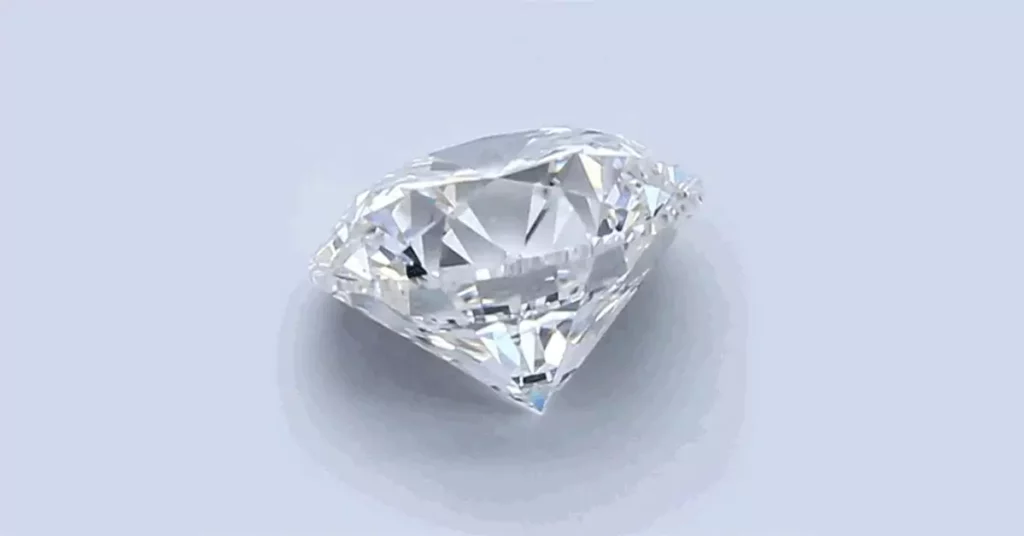
To summarize, diamond shape and cut are not the same thing, and choosing the right shape of diamond can have a significant impact on the beauty and value of the diamond. Round, princess, emerald, asscher, oval, marquise, pear, heart, and cushion are some of the most popular diamond shapes. When selecting a diamond shape, it is critical to consider the length to width ratio, as this can affect the diamond’s appearance and sparkle. By understanding the different shapes and ratios, I hope I have educated you to make an informed decisions when selecting your ideal diamond.
The ideal shape of a diamond for an engagement ring is a matter of personal preference. However, the most popular shapes for engagement rings are round, princess, cushion, oval, and pear. Round diamonds are the most classic and traditional shape, while princess cut diamonds are known for their modern and edgy look. Cushion cut diamonds have a vintage feel and offer a unique blend of brilliance and fire, while oval, pear-shaped and marquise diamonds are elegant and elongated, making fingers appear longer and slimmer. It is important to choose a shape that suits the recipient’s personal style and taste, as well as their lifestyle and practical considerations.
When choosing the ideal pair of diamond stud earrings for different face shapes, it’s important to consider the balance and proportion of the earrings with the wearer’s face. Here are some general guidelines: Round face: Balance out the roundness of the face by choose diamond stud earrings that are elongated or angular, such as oval, pear, or princess cut diamonds. Oval face: An oval face shape is well-suited to most diamond shapes, but round or princess cut diamonds are particularly flattering. Square face: Soften the angles of a square face by choosing diamond studs with curved edges, such as oval or round diamonds. Heart-shaped face: Heart-shaped faces are widest at the forehead and taper down to a point at the chin. To balance out this shape, look for diamond studs with wider bottom portions, such as pear shaped or marquise diamonds. Long or rectangular face: To create the illusion of width and balance out a long or rectangular face shape, look for diamond studs with wider shapes, such as oval or pear-shaped diamonds. Of course that these are just very general guidelines, and ultimately the best diamond stud earrings for any face shape depend on personal style and preference. Try on different shapes and styles to find the perfect pair of diamond stud earrings for you.
The round brilliant cut diamond has the most sparkle and shine out of all the diamond shapes. It has 58 carefully placed facets that are set up to reflect and refract almost all the light that enters it. That is why it is the most popular shape of diamond that you find in jewelry
The round brilliant cut diamond is the most popular diamond shape for engagement rings and other fine jewelry. This is due to its exceptional ability to refract light performance and overall beauty, as well as its classic and timeless appeal. Other popular diamond shapes include the princess cut, cushion cut, oval cut, and pear-shaped diamonds.
• A diamond’s shape greatly affects its visual appeal and value.
• Diamonds come in a wide variety of shapes, ranging from rounds to princess, cuts, emerald, asscher, oval, marquise, pear, heart, and cushion.
• A diamond’s shape and cut are two entirely different aspects and both are equally important to its sparkle and value.
• Each diamond shape has a different optimal length to width ratio to best refract light and sparkle.
Diamond earrings could be yours,
take part in our monthly giveaways
Shop by metal
Shop by diamond
@ All rights reserved La Joya Jewelry Inc